Ⅰ. Power Supplies - Board Mount
Ⅱ. Physical Characteristics of Power Supplies - Board Mount
Ⅲ. Electrical Characteristics of Power Supplies - Board Mount
Power supplies are electronic devices that convert the available electrical power into the required voltage, current, and frequency to power other electronic components and devices. Board mount power supplies are a type of power supply that is mounted directly on a printed circuit board (PCB).

Board mount power supplies are used in a wide range of electronic devices and applications, including industrial control systems, telecommunications equipment, medical devices, and consumer electronics. They come in various sizes and power ratings, from small and low power to large and high power, and are available in different types, including AC/DC and DC/DC converters.
AC/DC converters convert alternating current (AC) voltage into direct current (DC) voltage, while DC/DC converters convert one DC voltage level into another. Board mount power supplies typically have a universal input voltage range that can accommodate input voltages from 85 VAC to 264 VAC, making them suitable for use in a wide range of countries and regions.
Board mount power supplies can be single-output or multiple-output. Single-output power supplies provide one fixed voltage level, while multiple-output power supplies provide multiple voltage levels. The output voltage and current can be adjusted using built-in trimmer potentiometers or external resistors.
Board mount power supplies are designed for easy installation on a PCB, with mounting holes and pins that align with the holes and pads on the PCB. They can be mounted on either the top or bottom of the PCB, depending on the application.
Board mount power supplies are electronic devices that convert electrical power into the required voltage, current, and frequency to power other electronic components and devices. They are available in various sizes, power ratings, and types and can be mounted directly on a PCB. Board mount power supplies are commonly used in a wide range of electronic devices and applications.
Physical Characteristics of Power Supplies - Board Mount
The physical characteristics of board mount power supplies can vary depending on their design and intended use. Here are some important physical characteristics to consider when selecting a board mount power supply:
Size: The size of a board mount power supply can vary widely depending on its power rating and features. Smaller power supplies are suitable for low-power applications, while larger power supplies are necessary for high-power applications.
Mounting Type: Board mount power supplies are designed to be mounted directly onto a printed circuit board (PCB). They can be mounted on either the top or bottom of the PCB, depending on the application.
Form Factor: Board mount power supplies can have different form factors, such as open-frame, enclosed, or encapsulated. Open-frame power supplies are suitable for applications where space is limited, while enclosed or encapsulated power supplies provide protection from environmental factors such as dust and moisture.
Input Voltage Range: Board mount power supplies typically have a universal input voltage range, allowing them to operate from a wide range of input voltages, such as 85 VAC to 264 VAC.
Output Voltage and Current: Board mount power supplies can have a fixed or adjustable output voltage and current. The output voltage and current can be adjusted using built-in trimmer potentiometers or external resistors.
Efficiency: The efficiency of a board mount power supply is an important consideration, as it affects the amount of power that is lost as heat. Higher efficiency power supplies are more energy-efficient and generate less heat, reducing the need for additional cooling.
Board mount power supplies come in various sizes, form factors, and power ratings, and are designed to be mounted directly onto a printed circuit board. Other important physical characteristics to consider include the input voltage range, output voltage and current, and efficiency. By understanding these physical characteristics, you can select the appropriate board mount power supply for your application.
Electrical Characteristics of Power Supplies - Board Mount
The electrical characteristics of board mount power supplies can vary depending on their design and intended use. Here are some important electrical characteristics to consider when selecting a board mount power supply:
Output Voltage: The output voltage of a board mount power supply can be fixed or adjustable. Fixed output voltage power supplies provide a constant output voltage, while adjustable output voltage power supplies allow the output voltage to be adjusted within a specified range.
Output Current: The output current of a board mount power supply refers to the amount of current that it can deliver to the load. It is typically specified as a maximum current rating.
Ripple and Noise: Ripple and noise are unwanted variations in the output voltage or current of a power supply. They can be caused by various factors, including the power supply design, the input voltage, and the load. The amount of ripple and noise is typically specified as a percentage of the output voltage.
Efficiency: The efficiency of a board mount power supply refers to the percentage of input power that is converted to usable output power. Higher efficiency power supplies are more energy-efficient and generate less heat, reducing the need for additional cooling.
Input Voltage Range: Board mount power supplies typically have a universal input voltage range, allowing them to operate from a wide range of input voltages, such as 85 VAC to 264 VAC.
Protection Features: Board mount power supplies can include various protection features, such as overvoltage protection, overcurrent protection, and overtemperature protection. These features help protect the power supply and the load from damage in the event of a fault or abnormal condition.
The electrical characteristics of board mount power supplies are important considerations when selecting a power supply for a particular application. Output voltage and current, ripple and noise, efficiency, input voltage range, and protection features are some of the key electrical characteristics to consider. By understanding these characteristics, you can select the appropriate board mount power supply for your application.
标签:powersupply



